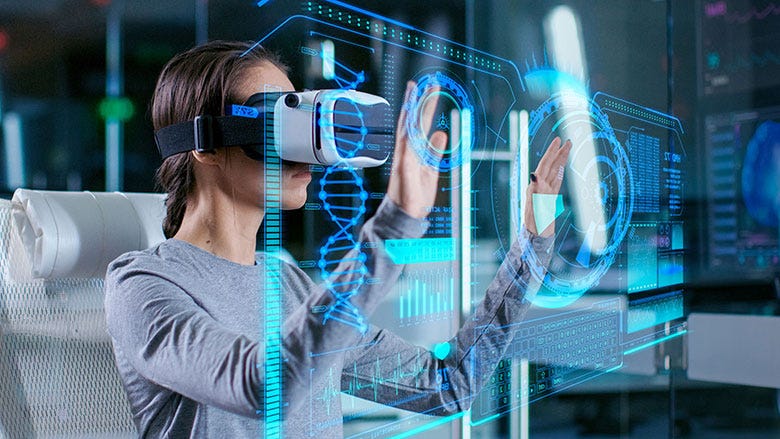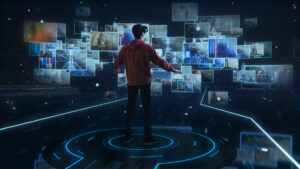Introduction
Virtual Reality, often abbreviated as VR represents a paradigm shift in human-computer interaction. It transports users from the physical world into digitally created environments, offering experiences that challenge our perception of reality.
The Genesis of Virtual Reality
The idea of VR has a long history. to the mid-20th century. Pioneers like Morton Heilig developed early immersive experiences, but it wasn’t until the late 20th century that the term VR gained prominence.
How Virtual Reality Works?
At its core, VR relies on advanced hardware and software systems. Headsets with motion sensors and displays create a simulated environment, while controllers or motion tracking enables users to interact with this virtual realm.
Applications Beyond Gaming
Healthcare and Medical Training VR facilitates realistic medical simulations, allowing medical professionals to practice surgeries and procedures in a safe and controlled environment.
-
Remote Collaboration
VR enables remote teams to collaborate improving communication and interaction as if they were in the same physical space productivity.
-
Education and Training
VR enhances learning by offering immersive educational experiences. Students can explore historical events, complex scientific concepts, and practical skills.
-
Mental Health Therapy
VR-based exposure therapy helps individuals confront and manage phobias, anxiety, and trauma in controlled environments.
-
Entertainment and Gaming
VR offers an immersive gaming experience, allowing players to interact with virtual worlds, characters, and challenges.
-
Architectural Visualization
VR transforms the design process by providing clients with interactive walkthroughs of architectural projects.
-
Virtual Tourism and Travel
Users can virtually explore destinations, landmarks, and historical sites, providing a new dimension to travel experiences.
-
Industrial Training and Simulations
Industries like aviation and manufacturing uses VR for training simulations, allowing employees to practice procedures without real-world risks.
-
Empathy and Awareness Building
VR experiences can evoke empathy by immersing users in the experiences of others, fostering understanding and awareness.
-
Architecture and Design Visualization
Architects and designers use VR to create interactive 3D models, enabling clients to explore and make informed decisions about their projects.
The Future of VR:
It is poised to shape a future where our digital and physical realities seamlessly merge. As technology advances, VR’s impact on various aspects of our lives is
expected to be transformative..
-
Personalized Learning
In education, VR will enable customized learning experiences. Students are allowed to research topics on their own. Pace, engage in interactive simulations, and receive tailored feedback, leading to more effective learning outcomes.
-
Cultural Transformation
VR will impact how we experience culture and history. Museums can offer virtual tours of historical sites, and users can explore different eras and civilizations in immersive detail.
-
Therapeutic Breakthroughs
Mental health therapy will see breakthroughs with VR. Innovative treatments will help individuals manage anxiety, phobias, and trauma by exposing them to controlled virtual environments.
-
Accessibility and Inclusivity
As VR technology becomes more accessible and affordable, it will bridge gaps in accessibility. People with disabilities can experience activities and places that might have been previously challenging.
-
Enhanced User Experiences
VR will continue to elevate user experiences, offering immersive interactions that engage multiple senses. VR will blur the lines between entertainment, education, and training.
Between the virtual and the real, providing a new level of engagement. Industry Disruption. VR’s capabilities will disrupt industries across the board. Healthcare, architecture, education, and more will benefit from realistic simulations, immersive training, and enhanced communication through VR
Challenges and Considerations of VR:
VR technology brings exciting possibilities but also difficulties that need to be resolved. For its successful integration. Here are key challenges and considerations:
-
Ethical and Privacy Issues
As VR becomes more integrated into daily life, privacy and data security concerns arise. Proper data handling and privacy safeguards are imperative.
-
Health and Safety Concerns
Extended VR use can lead to physical discomfort, including eye strain and fatigue. Prioritizing user comfort and well-being through design and guidelines is crucial.
-
Content Quality and Diversity
Sustaining interest in VR relies on a diverse range of engaging content. Developers must continuously create high-quality experiences to avoid stagnation.
-
Ethical and Social Implications
As VR blurs the line between reality and simulation, ethical considerations arise. Issues like addiction, privacy concerns, and the impact on human relationships are being discussed as technology evolves.
-
Motion Sickness and Discomfort
Some users experience motion sickness and discomfort when exposed to rapid movements in VR environments. Finding ways to reduce these effects is essential for a comfortable experience.
-
Learning Curve and User Familiarity
Navigating virtual environments and Using VR hardware can be challenging for newcomers. Designing user-friendly interfaces and providing educational resources can ease the learning curve.
-
Hardware Requirements and Accessibility
High-quality VR experiences often demand powerful hardware, limiting accessibility for users without suitable equipment. Addressing hardware requirements can make VR more inclusive.
Conclusion:
Virtual Reality has transcended its early sci-fi roots to become an integral part of the technological landscape. Its applications are vast, and its potential is transformative, promising a future where the boundaries between the physical and virtual worlds are further
blurred.
Frequently Asked Questions (FAQs)
-
Can VR be used for therapy?
Yes, It is increasingly used in therapeutic contexts. VR-based exposure therapy helps individuals confront and manage phobias, anxiety, and trauma in controlled environments. It provides a safe space for patients to work through their challenges with the guidance of mental health professionals.
-
Is VR only for gaming?
No, It has applications far beyond gaming. While gaming is a notable use case, VR is also employed in healthcare, architecture, education, and more industries. It creates immersive experiences that extend well beyond the realm of entertainment.
-
How might VR change the way we work and communicate?
VR has the potential to revolutionize the way we work and communicate. It could enable remote collaboration, allowing teams to interact as if they were in the same physical space. Virtual meetings, training sessions, and collaborative projects could become more immersive and engaging, transcending geographical boundaries.


